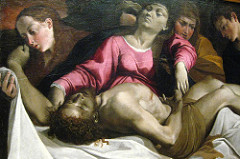
Artist: Giotto
Patron: Enrico Scrovegni
Form: stage space, layering for impression of depth, individualized faces seen through example such as knitted brows, emphasis on the emotional aspect depicting sorrow and loss, vibrant use of color, gold flat halos present
Function: of the Scrovegni Chapel alongside other scenes of Christ’s life, beautifies chapel, personal propaganda and reputation
Content: Through this Lamentation scene, Christ has been taken off the cross, where surrounding others mourn and grieve over his body. Evidently, these mourners are reacting to his death.
Context: This piece exceedingly portrays and conveys the emotional appeal, therefore it is similarly present and indicated in the mass. By integrated this very real and heart wrenching emotion of loss, the mass is elevated to an entirely different level and is dramatized. The stage space, furthermore, reflects the clergy’s “stage” in front of the mass and message.
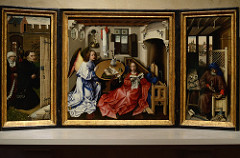
Artist: Robert Campin
Patron: Peter Inghelbrecht
Form: rendering of realism and naturalistic figures, significant modeling to create mass and volume, clothing of the figures drifts along with them, highly symbolic, representative of the scene moreover, depicts the clothing style seen at the time period, perspective quite off, although it’s an attempt
Function: personal reputation
Content: simply, the Annunciation scene, depicting Virgin Mary, wearing red as a symbol of the blood of Christ and holding a book, with the angel Gabriel. The left panel shows the patron himself in the painting, while the right panel illustrates Joseph working in his workshop. Additionally, Mary is symbolized in this sense as an appropriate vessel for Jesus Christ.
Context: Altar pieces are for private homes currently, therefore this is for the patron’s home, not a church as soon before. This further influences the more intimate connection to Mary, since the Annunciation scene has also appeared to take place in a living room setting in the actual piece of art. This piece also is a strong indicator of earlier Renaissance because the perspective isn’t quite right.
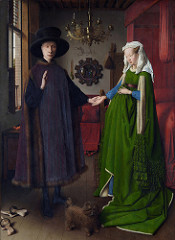
Artist: Jan Van Eyck
Patron: Giovanni Arnolfini
Form: concentrated with symbolism, represents the high fashion and wealth at this time, breathing figures in position, mirror reflects the priest and artist
Function: portrait; for personal recognition and propaganda, references to employer of the Medici Family
Content: Formal setting in which the man (patron) marries a woman. No shoes are on the woman’s feet, indicating a sacred event, since a wedding is quite sacred. In addition, the dog symbolizes fidelity and the woman’s pregnant appearance signifies that the marriage will be fruitful and they will produce offspring.
Context: Of course, the patron would love to show off that he works for the Coat of Arms and the most wealthiest families of the Renaissance. This reference is seen through the orange fruit behind Arnolfini. He is a banker and works for the Medici in the North; he definitely wants it known that he works for them. Also, producing offspring was vital and the expectation in society, so that is also represented through the woman’s body.

Period: Southern Renaissance (1450 CE)
Artist: Fra Filippo Lippi
Patron: unknown
Form: Christ depicted as a fat, nourished, healthy, lively baby, naturalism; Mary designated, Queen of Heaven-like pose, rigid somewhat, appropriate colors, not as relaxed, in prayer, dignified, realistic; Mary casts shadow behind the frame, use of space and figures fill the composition, defined lines to extenuate and draw out vital parts of the body; gives an elegance and posed look to Mary, makes her more gentle and soft; much attention to detail and grace of the face, anatomy, lighting, contour, representative divinity of halo (not as prominent as Byzantine)
Function: portrait of Mary and Christ; Mary is more realistic and gentle as a motherly figure, therefore connecting with the audience more
Content: The Virgin Mary holds baby Jesus, surrounded by putti (angelic helpers) who are supporting him by lifting him up to her.
Context: Lippi heavily influenced by Ghiberti’s Gates of Paradise in terms of outlining his forms; as a painter, influenced by Massachio; this specific piece contains his live model and mistress and Mary.
Artist: Sandro Botticelli
Patron: Medici Family
Form: not focusing on realistic anatomy, shoulders are slanted and sloped, odd positioning of arms, shifting to the symbolism and scene more importantly
Function: literal depiction to passages of the poem of the birth of Venus; contemporary event with poem references
Content: portrayal of Venus’ birth; Venus rides in on a shell from being born from the sea, pushed by the western wind to the island of Cyprus where the goddess Pomona clothes her
Context: Typically, an artwork such as this is to be considered pagan, which is evidently not allowed by the church nor society. However, it was commissioned by the powerful and wealthy Medici, and although it represents mythology and is sacrilegious, the Medici can pretty much do whatever.

Artist: Leonardo da Vinci
Patron: Duke of Milan
Form: interactive with environment surrounding, captures the naturalistic reactions, pyramental composition for symmetry, balance, order, logical placement, organization, etc; fresco, oil and tempra on plaster, Christ vocal point, with the vanishing point hanging above his head, seen through the coffered ceiling and natural line of sight; didn’t need to use halo because of the already natural illumination of the lighting, increase in intensity of emotion and void of calm towards Christ; isn’t recognizable as a painting, but as an extension of the room
Function: depicting the scene of Christ’s last supper with the disciples; hung in refectory (formal term for cafeteria or dining hall)
Content: Christ is with his disciples and is telling them how one of them will betray him; da Vinci freezes the natural, raw emotions of all the individuals before they attempt to mask it and play off the news
Context: Through da Vinci’s commissions, he experimented with different mediums; High Renaissance is huge on organization and symmetry, reflectant on Classical Greece influence
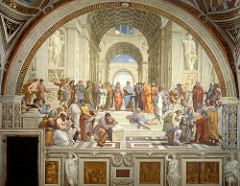
Artist: Raphael
Patron: Pope Julius II
Form: symmetrical, mathematical, organized in complete precision and perfection, balanced, measured, appropriate level of perspective measured out, reincorporates the idea of an extension of the room, figures natural and in motion, rendered realistic
Function: retrace back to the roots of the Classical age and way of philosophy; the pope can appear as “the man of the world” as a spiritual and temporal leader
Content: Plato and Aristotle are the focal points, centered in the piece; Classical though and reference to Greek mythology as Apollo and Athena are present; depicts the duality of the two different types of philosophy (what can be seen and what cannot)
Context: As much as humanism is vital in the Renaissance, so is understanding the classics and being well rounded in that knowledge and wisdom. Artists now are in charge of workshops, where grunt work is done by their apprentices, seen through background work in this piece. The location of this piece was in a themed room, where the opposite wall was a religious painting; this demonstrated the juxtaposing yet honorable authority and reputation of Pope Julius II

Artist: Michelangelo
Patron: Pope Julius II
Form: exceedingly built, buff, muscular, massive figure; bright, vibrant, bold color, particularly yellow; trick for the eye, putti in the background, idealized, rendered anatomically correct, humanism, concentrated, drawn glance; figure in profile, extenuated lines of face, neck, and curvature
Function: fresco for the Sistine Chapel, which depicted stories from the Bible
Content: Delphic has the meaning of the most famous, sacred prophet to Apollo, almost like an oracle. Sibyl means prophet from Ancient Greece. Therefore, this Delphic Sibyl holds a scroll, symbolic to the function of their role as a prophet; in recorded history, always consulted.
Context: commemorates the Classical Greek influence in High Renaissance
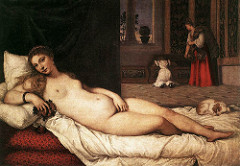
Artist: Titian
Patron: Duke of Urbino
Form: figures look glowing due to lighting; oil allows for manipulation and illumination with glazes and light; the Golden ratio/section for ideal proportions and perfection of the body; symmetrical; enticing, sensual, draws immediate attention for the Duke; balanced throughout seen through the motif of red in the foreground and background; depth and harmony demonstrated on the Z axis of the painting; motif seen through the woman’s hair and dog’s hair; graceful positioning
Function: to be hung in the Duke’s private office; wanted a portrait of his mistress nude
Content: The Duke’s nude mistress reclined in pillows; depicted as almost like a goddess, representative of Aphrodite; elevates her to a goddess status; dog symbolizes fidelity (asleep), ladies in waiting picking out her impressive clothing for the day
Context: compared and contrasted to the earlier work of the Sleeping Venus pose with a new setting, which his master Gorgionni completed.

Artist: Mathias Grunewald
Patron: Guido Guersi
Form: awfully brutal, gruesome; not a washed version of the typical scene; dried, strained, malnourished, emaciated Christ, skin dragging and hanging over him, looks like he is diseased; emphasizes the sacrifice, however most importantly humanizes him through his agony and torture; closed altarpiece
Function: bring humanism into Christ’s death; focus for worship and serves as dramatic backdrop; altarpiece inside the hospital of the monastery of St. Anthony, so that the patients may identify their suffering with Christ’s
Content: Christ possesses qualities of diving healing, for example, contextually during the plague; specific to audience’s suffering, calming; white symbolizes hope, lamb symbolizes the sacrifice of Christ; Virgin Mary, Mary Magdalene present
Context: putting into true emotion into artwork; reinforces what it means to identify the piece of art with the audience and how it may influence the reader’s perception
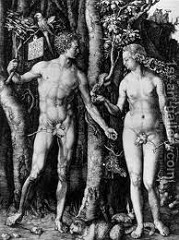
Artist: Albrecht Durer
Patron: unknown
Form: body on Adam rendered perfectly; mathematically proportionally and perfect, idealized, both figures in contrapposto; Eve depicted masculine (due to a nude woman vs. social norms); both wrappes inside the forest and foliage
Function: woodcut; scene of Adam and Eve
Content: Adam and Eve are alongside the trickery of the snake and possess the doomed fruit of mankind. Symbolism in all of the animals that represent a type of body fluid (blood, yellow bile, black bile, phlegm), along with the mouse and the cat represented Christ as a trap to ensnare the devil.
Context: Piece displays Durer’s ability to travel and his skill of replication of natural, real objects, for example, plants he drew from Italy. In addition, he studied the Vetruvian theory/Vetruvian man from da Vinci and highly used it in his work.

Artist: Pieter Bruegel the Elder
Patron: unknown
Form: realism throughout all the figures, perspective key, far out vanishing point, basic, neutral colors, prominent use of yellows and browns and blues
Function: collection of proverbs
Content: quite literal form of the variety of sayings and proverbs, rendered in paint
Context: At this point of time, there is a decrease of patronage and commissions done. Transitioning into age of buying and selling artwork without necessary function or content.

Artist: Pieter Bruegel the Elder
Patron: unknown
Form: fore, middle, and background clearly represented, depthful, focus on the landscape and townsetting, perspective is noted
Function: genre painting
Content: simply hunters hunting on a snowy evening
Context: Apart of the humanism aspect of the Renaissance, the artist also incorporated the indication that he has traveled. A painting served as like a “resume”, if you will, and noted the artists’ recognition.





